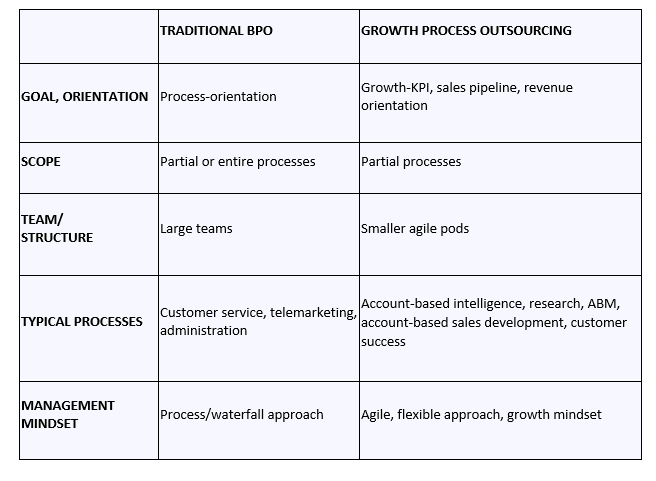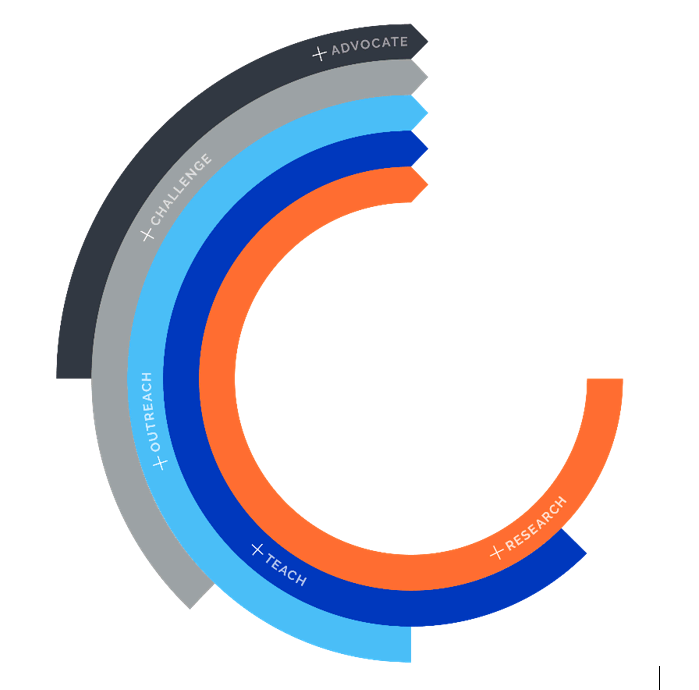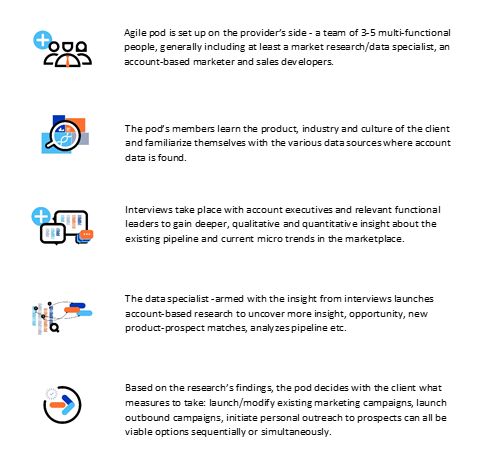| PULSE: A New Business Model for Outsourcing Enterprise Growth Activities: Growth Process Outsourcing | |

A New Business Model for Outsourcing Enterprise Growth Activities: Growth Process Outsourcing
By: Ronald David, Client Success Director, Infinityn International
In this contributed story by Infinityn International, learn about the possibilities and success of outsourcing enterprise sales and marketing. The software growth specialist was identified as a ‘Rising Star’ in this year’s IAOP 2022 Global Outsourcing 100 List.
For more on this topic, register for the September 29 webinar, Beating the Downturn and Mitigating Risk by Growth Process Outsourcing, featuring Ronald David, Client Success Director, Infinityn International and Kate Varvedo, Head of Marketing, Infinityn International.
Outsourcing remains a red-hot trend. While its broader growth is recognized, a subtrend is emerging in an area that has not traditionally been regarded as a business function to be outsourced: enterprise sales and marketing.
Despite the growth of outsourced services having slowed down over the past few years, the global market size has doubled in total value. Between 2000 and 2019, the total valuation of services rose to a staggering 92.5 billion dollars annually, according to a Business Process Outsourcing worldwide report.
Outsourcing has been redrawing core business functions and, in many industries, and it has redefined the way business is done. Over the years, the outsourced business functions that have enjoyed the highest popularity have been changing; IT outsourcing has been making up a good chunk of the outsourcing pie, accounting for approximately two-thirds of all activities by contract value, according to Statista. However, IT outsourcing has not been rapidly growing in the 2010s, having even consolidated in some years of the past decade. The expansion in outsourcing has been driven by another segment.
This outsourcing function that is showing a rapid increase year-on-year - more abrupt than any other area - is customer experience/customer care. According to the above-cited Statista report, this segment is expected to almost double in size from an already impressive 17.45 billion dollars per year in 2017 to over 30 billion in just 10 years.
The expansion of this function is intriguing because it is an early indication of the rise of growth-process outsourcing (GPO): the outsourcing of B2B sales and marketing functions. To be fair, outsourcing sales and marketing activities isn’t at all entirely new: the most obvious “predecessor” of GPO is outsourcing telemarketing or telesales. However, telemarketing and telesales are only small pieces of the growth puzzle and they are generally inadequate for selling complex, high all-commodity volume (ACV) products. Outsourcing B2B sales and marketing functions as a part of growth process is qualitatively different, as we will explore later.
Growth Process Outsourcing
Growth Process Outsourcing is a framework for outsourcing complex enterprise marketing and sales processes. In a B2B enterprise setting, marketing and sales are increasingly conducted in an account-based fashion, and account-based growth commonly refers to the “combined” stack of marketing, sales and customer success activities.
In other words, GPO builds on the already established practice and framework of business process outsourcing and takes BPO to new grounds: scaling account-based marketing (ABM) and sales activities, which are also referred to as account-based growth activities. It complements, in an agile way, the account-based growth processes of enterprises.
GPO is similar to BPO in many ways, so it’s worth discussing the differences between the two concepts. A major difference between BPO and GPO is that most of the GPO elements follow a less exact process, and it also includes a higher element of research and consultative work. GPO blends research and execution and as such becomes somewhat different from traditional BPO setups.
Other key differences are highlighted in the table below:

To understand the nature, significance and possibilities of GPO, it’s worth briefly discussing the proven methodology of account-based growth. Account-Based Growth (ABG) is a systematic process for aligned B2B marketing-sales initiatives in the enterprise sphere, especially in the technology and service sector. ABG evolved from account-based marketing (ABM). ABM is a B2B marketing methodology that encourages shifting the marketing focus from lead generation to more holistic, account-targeted, personalized and relevant marketing that results in better buying experiences, making it more effective.
ABG is often referred to as Agile ABG because of its nature. ABG requires multidisciplinary teams, runs in sprints and is very similar to agile methodologies known in software development and marketing. Because of its agile nature, ABG “sits well” in a tech-business setting, where it is usually deployed. (Editors note: In the remainder of the article, we will sometimes refer to ABG as Agile ABG.)
While ABM has many successful applications and is regarded as the optimal B2B marketing methodology in high annual-contract value settings, it has one shortcoming: the original framework does not adequately address the issues around sales-marketing alignment, a common and major “complaint” of enterprise sales and marketing leaders.
Lack of alignment between sales and marketing departments results in data- and information silos, leading to suboptimal campaigns in both departments. Account-based growth comes to the rescue as a methodology that is more holistic in nature and encompasses both marketing and sales development processes and even the later customer journey stages: sales and customer success.
ABG also aids in aligning goals, defining metrics and minimizing silos between departments. On the one hand, account-based growth is a cure for teams running account-based marketing and experiencing inter-department misalignment. It is also a concise and straightforward framework for optimal B2B growth. In later stages of account-based growth, when customer success processes and teams are also involved in ABG projects, the result is an even more efficient growth cycle and a more satisfying buyer experience. Naturally, a more elevated customer experience also ends up fueling growth by making customer retention and upselling easier. These are the high-level results and benefits of using the more holistic approach to account-based growth.
Some common activities that take place in the scope of ABG projects or sprints include:
- Account-based intelligence: uncovering and unifying important sales and marketing information from various technology tools as well as account executives to gain new insight and shed light on new opportunity
- Creating and running efficient marketing campaigns using the existing tech stack in a more synchronized way
- Doing human-based sales-development: outreach to existing or new prospects. Agile Account-based Growth in its full form becomes a virtuous cycle, where sub-processes work in tandem and often run parallel to one another. The “account-based growth flywheel” can be depicted like this:

ABG Outsourced is GPO
For enterprises looking to implement account-based growth, using an external consultancy or service provider is a viable approach. By its nature, ABG has a consultative side with “fixing broken parts” in sales and marketing and as such, it’s often better done by an “outside eye” that is void of any blind spots.
In addition, an external provider will likely have more experience implementing an Agile ABG program, which saves time and resources. Lack of resources is a third reason companies outsource; internal sales and marketing resources are often tied up in existing campaigns and initiatives and it can be nearly impossible to find the time, focus and dedication for an ABG sprint internally.
The framework for cooperation in providing Agile ABG services (and subsequently using ABG services) is Growth-Process Outsourcing. The way companies have been using GPO is doing agile, small-scale pilot projects that are limited to specific geographies or products or other segments of growth activities.
This is a common process for outsourcing a growth process:

Outlook
As we see wider adoption of account-based marketing and the rapid spread of marketing- and sales technology, problems arise around inter-departmental alignment in growth teams, data silos and sub-optimal performance on both sales- and marketing fronts.
An agile approach, called account-based growth, is a holistic mindset and methodology that focuses on integrating key growth processes and eliminating data- and information silos. ABG can be a challenge to implement from inside the organization. This opens the doors for the emergence of providing ABG as a consulting- and implementation service, namely Growth-Process Outsourcing. GPO is an immense opportunity for providers who have experience in marketing and sales services at the enterprise level, as well as for their clients.